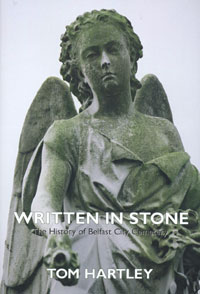14 December 2006 Edition
BOOK REVIEW

A novel contribution to the understanding of unionist history
Written In Stone (The History of Belfast City Cemetery),
By Tom Hartley,
Published by Brehon Press,
Price £14 99 H-B
Writing about history can be difficult. It is made all the more problematic when the history in question is contested. A recent and a novel contribution to understanding the history of the unionist and protestant people of this country has been written by Sinn Féin Councillor Tom Hartley.
This fascinating book introduces readers to some of the leaders and followers of Irish unionism living at a time of great human and political upheavals like the First World War, the 1916 Rising, the Tan War, Partition and the Civil War.
Tom’s primary source is equally fascinating. He recorded it as he saw it on the gravestones in Belfast’s City Cemetery - mainly but not exclusively a burial ground for unionists from a wealthy background.
The complexity of Irish history dominated as it has been by British occupation and colonialism for centuries is reflected in the personalities who lie buried in this graveyard.
Rutlidge Kane, a senior Orangeman was a leading opponent of Home Rule. He was also a patron of the Gaelic League and was responsible for the banner Erin go Bragh
on display at the Unionist Convention of 1892 and is described on his headstone as a ‘loyal Irish patriot’. John Sinclair Boyd was both a liberal unionist and the first President of the Belfast Gaelic League.
Here lie the rich and powerful – the movers and shakers of Victorian Belfast who pushed the city to the height of its industrial power; the people who held Ireland and Belfast for the British Empire before and after partition.
It is the resting place for politicians and businessmen, inventors and industrialists, Jews, Irish speaking Orangemen and republicans, British soldiers and IRA volunteers, pioneering women, educationalists, philanthropists, the privileged, prostitutes and paupers. Catholics and Protestants, separated in life, the authorities tried to separate them in death with a sunken wall in the graveyard!
The book provides a glimpse into the conditions in Ireland’s class-ridden society in the 19th and 20th centuries. The poor, especially children who died in their thousands from diseases like smallpox, chickenpox, mumps, measles, diphtheria and whooping cough, lie in unmarked graves.
The book, ten years in the making, came out of Tom’s republican experience. In 1973 when Belfast’s Falls Road was the centre of a war zone with others he opened the first republican press centre. For visiting journalists he was one of the first public faces of Sinn Féin. Their inquisitiveness led Tom to taking them on tours of British military barracks across West Belfast and the republican plot in Milltown cemetery.
An engagement on Sinn Féin’s behalf with the unionists opened Tom’s mind to their history.
This book is more than a history of Protestant and unionist Belfast. It is about the place and impact of that community on the politics of Ireland and as serving soldiers in the British Empire.
Tom attributes his interest in history to his ‘mother’s capacity for detail’ and his ‘father’s talent in story telling’.
The detail in this book is microscopic. The story telling is cleverly revealed in the personalities whose graves are recorded. It is a book version of an internet search engine with links that leap frog you to many places of interest.
Launched a few months ago the book has been a Number One best seller at Waterstone’s bookshop in Belfast. Its popularity has kept it among the top three and rightly so.
A very good choice for a book for a friend at Christmas.
BY JIM GIBNEY


